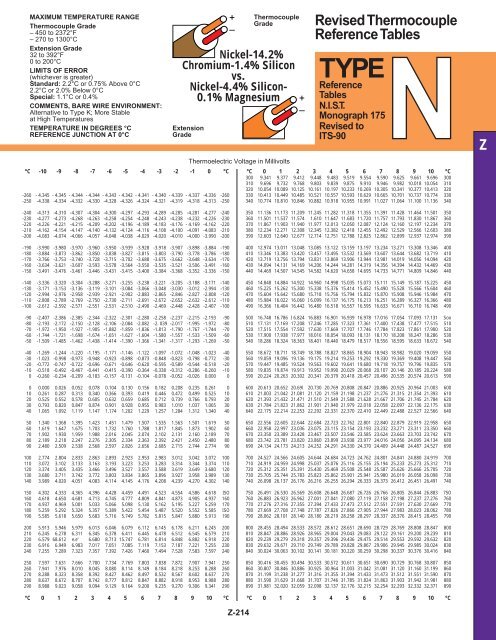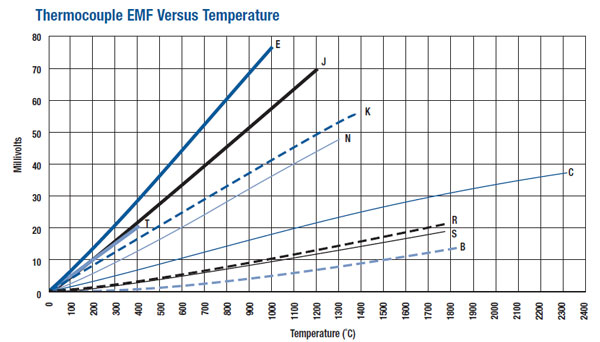

Energized by the heat from your skin, electrons will propagate from the area where you’re touching it to the cooler far end away from you, creating a temperature gradient along the length of the wire. Take a piece of bare copper wire and close your hand around it at one end.
#Type j to type k thermocouple conversion free
How is this possible? Are we creating free energy from nothing? Not at all - it’s just physics!Ĭonsider that electrons carry both electricity and heat. And they do this passively, i.e., they do not need to be powered by a signal conditioner. Thermocouples are based on the Seebeck effect, which says that when a pair of dissimilar metals in contact with each other at each end are subjected to changes in temperature, they create a small voltage potential. Click the image to zoom in:ĭifferent thermocouples characteristics How does a thermocouple work?

Made for high-temperature applications, but not oxidizing environmentsĪ detailed thermocouple comparison is available in the image below. High temperature, do not insert in metal tubes

Wide range of temperatures, more stable than type K Good for lower temperatures and damp environments.
#Type j to type k thermocouple conversion iso
Solutions by industry Aerospace Automotive Civil Engineering Education E-mobility Heavy Machinery Industrial Maritime Power and Energy RailwayĪll solutions ADAS Testing Brake Noise Testing Brake Testing Structural Health Monitoring of Bridges Combustion Measurement Machine Condition Monitoring Electric Motor and Inverter Testing Electric Vehicle Testing Fatigue Testing FFT Spectrum Analyzer Harsh Environment Testing Human Body Vibration - ISO 2631 Modal Testing and Modal Analysis Octave Band Analyzer Orbit Analysis Order Analysis Ground Station Telemetry Power Analyzer Power Quality Analyzer Power Transformer Testing Renewable Energy Testing RT60 Measurement Road Load Data Acquisition Torsional Vibration Analysis Rotor Balancing Shock Response Spectrum Sine Reduction Test Sound Level Measurement Sound Intensity Measurement Sound Power Measurement Sound Quality Measurement Structural Health Monitoring Temperature Recording Vehicle Dynamics Testing Voltage Data Loggers Wind Turbine Monitoring Wind Power Quality >Insulation resistance: ≥100MΩ among input, output, power supply.Solution by area Acoustics Data Recording Flight/Space Testing Monitoring NVH Testing Electrical Power Testing Rotating Machinery Structural Dynamics Vehicle Testing Vibration Analysis >1500VAC/min among input, output, power supply. >Thermocouple disconnection alarm: output 22mA or 3.8mA Higher than the upper temperature limit, output 20.5mA. >Exceed limit alarm: Lower than the bottom temperature limit, output 3.8mA,when output is 4-20mA >Current consumption: ≤50mA 20mA output,1-channel input/output. >Output load resistance: RL≤500Ω, when output is current signal. >Cold junction compensation range: -20℃-+70℃ (Error 1℃ per 20℃) internal compensation mode

>Industrial operating temperature range: -20-+70℃. >Slim package, the width is only 12mm, which occupies less space. >1.5KV (0.5mA,60S) 3-way isolation voltage among input, output, operating power supply. >Have PTC automatic cold-junction compensation >Accuracy grade: 0.5 (FSR%), high linearity. >1-Channel K-type Thermocouple signal input, 1-channel DC current/voltage output. That type-k thermocouple signal conditioning module can provide low-cost high-performance solution for customers. Its output signal can be 4-20mA, 0-20mA, 0-5V, 0-5V. The signal can be used for digital instrumentation recorder, analog regulator, DCS system, widely used in industrial processes detection and control system. BRT TCK-D11 Thermocouple to analog 4-20mA, 0-5V, 0-10V Converter deals with the temperature changes measured by thermocouple TC through the processing circuit into a standard voltage or current signal after signal amplification.


 0 kommentar(er)
0 kommentar(er)
